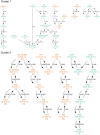Population structure of Bartonella henselae in Algerian urban stray cats
- PMID: 22956995
- PMCID: PMC3428342
- DOI: 10.1371/journal.pone.0043621
Population structure of Bartonella henselae in Algerian urban stray cats
Abstract
Whole blood samples from 211 stray cats from Algiers, Algeria, were cultured to detect the presence of Bartonella species and to evaluate the genetic diversity of B. henselae strains by multiple locus VNTR analysis (MLVA). Bartonella henselae was the only species isolated from 36 (17%) of 211 cats. B. henselae genotype I was the predominant genotype (64%). MLVA typing of 259 strains from 30 bacteremic cats revealed 52 different profiles as compared to only 3 profiles using MLST. Of these 52 profiles, 48 (92.3%) were identified for the first time. One-third of the cats harbored one MLVA profile only. As there was a correlation between the age of cats and the number of MLVA profiles, we hypothesized that the single profile in these cats was the profile of the initial infecting strain. Two-third of the cats harbored 2 to 6 MLVA profiles simultaneously. The similarity of MLVA profiles obtained from the same cat, neighbor-joining clustering and structure-neighbor clustering indicate that such a diversity likely results from two different mechanisms occurring either independently or simultaneously: independent infections and genetic drift from a primary strain.
Conflict of interest statement
Figures






Similar articles
-
Combined MLST and AFLP typing of Bartonella henselae isolated from cats reveals new sequence types and suggests clonal evolution.Vet Microbiol. 2011 Mar 24;148(2-4):238-45. doi: 10.1016/j.vetmic.2010.08.012. Epub 2010 Sep 21. Vet Microbiol. 2011. PMID: 20863631
-
[Prevalence of Bartonella henselae in stray and domestic cats in different Italian areas: evaluation of the potential risk of transmission of Bartonella to humans].Parassitologia. 2004 Jun;46(1-2):127-9. Parassitologia. 2004. PMID: 15305701 Review. Italian.
-
Prevalence of Bartonella henselae and Bartonella clarridgeiae in stray cats.J Clin Microbiol. 1997 Jun;35(6):1327-31. doi: 10.1128/jcm.35.6.1327-1331.1997. J Clin Microbiol. 1997. PMID: 9163438 Free PMC article.
-
Genetic characterization of Bartonella henselae samples isolated from stray cats by multi-locus sequence typing.BMC Vet Res. 2023 Oct 7;19(1):195. doi: 10.1186/s12917-023-03748-4. BMC Vet Res. 2023. PMID: 37805521 Free PMC article.
-
Recommendations for treatment of human infections caused by Bartonella species.Antimicrob Agents Chemother. 2004 Jun;48(6):1921-33. doi: 10.1128/AAC.48.6.1921-1933.2004. Antimicrob Agents Chemother. 2004. PMID: 15155180 Free PMC article. Review. No abstract available.
Cited by
-
Blood culture-negative endocarditis caused by Bartonella quintana in Iran.Sci Rep. 2024 Oct 30;14(1):26063. doi: 10.1038/s41598-024-77757-0. Sci Rep. 2024. PMID: 39478136 Free PMC article.
-
A new multiple-locus variable-number tandem repeat analysis reveals different clusters for Anaplasma phagocytophilum circulating in domestic and wild ruminants.Parasit Vectors. 2014 Sep 16;7:439. doi: 10.1186/1756-3305-7-439. Parasit Vectors. 2014. PMID: 25228371 Free PMC article.
-
Epidemiology of Bartonella henselae infection in pet and stray cats in Croatia with risk factors analysis.Parasit Vectors. 2024 Feb 1;17(1):48. doi: 10.1186/s13071-024-06117-8. Parasit Vectors. 2024. PMID: 38303085 Free PMC article.
-
Hemotropic Mycoplasma and Bartonella Species Diversity in Free-Roaming Canine and Feline from Luanda, Angola.Pathogens. 2021 Jun 10;10(6):735. doi: 10.3390/pathogens10060735. Pathogens. 2021. PMID: 34200906 Free PMC article.
-
Detection of Bartonella tamiae, Coxiella burnetii and rickettsiae in arthropods and tissues from wild and domestic animals in northeastern Algeria.Parasit Vectors. 2016 Jan 20;9:27. doi: 10.1186/s13071-016-1316-9. Parasit Vectors. 2016. PMID: 26791781 Free PMC article.
References
-
- Boulouis HJ, Chang CC, Henn JB, Kasten RW, Chomel BB (2005) Factors associated with the rapid emergence of zoonotic Bartonella infections. Vet Res 36: 383–410. - PubMed
-
- Breitschwerdt EB, Maggi RG, Chomel BB, Lappin MR (2010) Bartonellosis: an emerging infectious disease of zoonotic importance to animals and human beings. J Vet Emerg Crit Care (San Antonio) 20: 8–30. - PubMed
-
- Drancourt M, Birtles R, Chaumentin G, Vandenesch F, Etienne J, et al. (1996) New serotype of Bartonella henselae in endocarditis and cat-scratch disease. Lancet 347: 441–443. - PubMed
-
- Viezens J, Arvand M (2008) Simultaneous presence of two different copies of the 16S rRNA gene in Bartonella henselae. . Microbiology 154: 2881–2886. - PubMed
Publication types
MeSH terms
LinkOut - more resources
Full Text Sources
Research Materials
Miscellaneous

